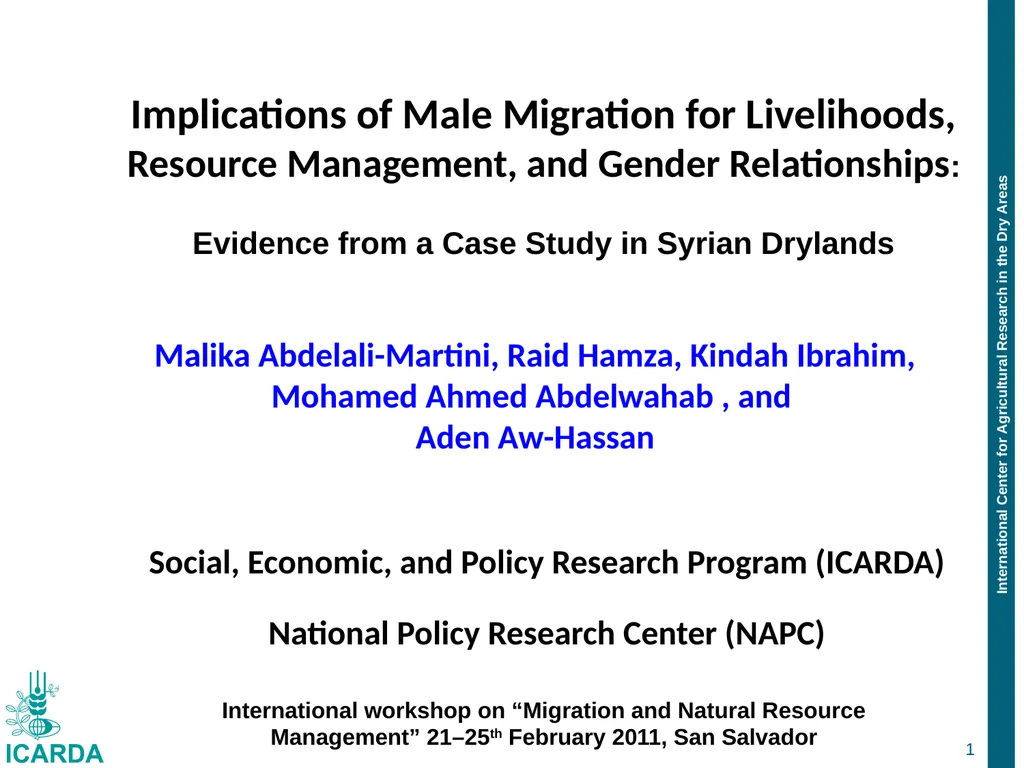Implications of Male Migration for Livelihoods,
Author : pamella-moone | Published Date : 2025-11-07
Description: Implications of Male Migration for Livelihoods Resource Management and Gender Relationships Evidence from a Case Study in Syrian Drylands 1 Social Economic and Policy Research Program ICARDA National Policy Research Center NAPC
Presentation Embed Code
Download Presentation
Download
Presentation The PPT/PDF document
"Implications of Male Migration for Livelihoods," is the property of its rightful owner.
Permission is granted to download and print the materials on this website for personal, non-commercial use only,
and to display it on your personal computer provided you do not modify the materials and that you retain all
copyright notices contained in the materials. By downloading content from our website, you accept the terms of
this agreement.
Transcript:Implications of Male Migration for Livelihoods,:
Implications of Male Migration for Livelihoods, Resource Management, and Gender Relationships: Evidence from a Case Study in Syrian Drylands 1 Social, Economic, and Policy Research Program (ICARDA) National Policy Research Center (NAPC) Malika Abdelali-Martini, Raid Hamza, Kindah Ibrahim, Mohamed Ahmed Abdelwahab , and Aden Aw-Hassan International workshop on “Migration and Natural Resource Management” 21–25th February 2011, San Salvador 2 Study Area 3 Study Area The Study Area Jabal al-Hoss is one of the poorest areas in Syria Jabal al-Hoss with its 157 villages is one of the poorest areas in Syria The villages have the shape of mud domes Life is harsh, given the rocky surface of the land and the dry climate Yet there is potential in rural areas, that can be supported by external funding Harsh environment Sustainable Resource Management Conservation of NR: Soil conservation in drylands Improved range management in pastoral areas Land degradation and sustainability in dry areas This could be through: Support to local resource-user groups; Better management practices Improved long-term policies. Drylands face a number of converging trends High population growth rates of up to 3% Regions that are already water scarce and will be increasingly so, (climate change predictions: regions become hotter and drier) Increasing dependency on grain imports Increasing desertification and loss of biodiversity Increasing out-migration of males from rural areas Problems of access to international markets Climate Soil Long, hot and dry summers Rain falls Sept-May, with peak during Dec-Jan Long term annual rainfall is appr. 220 mm, reduces towards the steppe High variability of annual and inter-annual rainfall Jabal Al-Hoss is a gently undulating plain Basaltic on hills, forming gently rolling plateaus Slopes covered with stones, and incised with v-shaped erosion channels Soils on slopes are of variable thickness, but generally shallow (<1 m-16 m, well drained with high infiltration capacity Rangeland Degradation Major Economic Activities Majority of the population involved in agriculture Three main types of agricultural production systems Rainfed farming Irrigated farming and livestock Rearing Major economic activities con’t Combination of crop production and livestock rearing Barley as the dominant crop, occupies the major part of the arable land Off-farm activities are very important in providing sufficient income in this resource-poor area About 43% of hhs have one or more members working as off-farm labor, 15% of hhs have members working as labor in cities, and 16% of hhs have members working outside Syria Environmental/ Economic Constraints Rainfall













